FAQ: What is PCB in Fish?
- Last Updated: June 12th, 2025

Attorney Jessie Paluch, founder of TruLaw, has over 25 years of experience as a personal injury and mass tort attorney, and previously worked as an international tax attorney at Deloitte. Jessie collaborates with attorneys nationwide — enabling her to share reliable, up-to-date legal information with our readers.
Legally Reviewed
This article has been written and reviewed for legal accuracy and clarity by the team of writers and legal experts at TruLawsuit Info and is as accurate as possible. This content should not be taken as legal advice from an attorney. If you would like to learn more about our owner and experienced injury lawyer, Jessie Paluch, you can do so here.
Fact-Checked
TruLawsuit Info does everything possible to make sure the information in this article is up to date and accurate. If you need specific legal advice about your case, contact our team by using the chat on the bottom of this page. This article should not be taken as advice from an attorney.
Key Takeaways:
- PCBs in fish can pose health risks due to their ability to accumulate in animal tissue and persist in the environment.
- Consuming a diet rich in fish has numerous health benefits, but caution is advised due to the potential presence of PCBs in some fish species.
- Adherence to fish consumption advisories is important for reducing the risks associated with PCB exposure.
Overview of What is PCB in Fish?
On this page, we’ll discuss What is PCB in Fish?, to provide an overview of how PCBs accumulate in fish, risks associated with consuming PCB-contaminated fish, and much more.
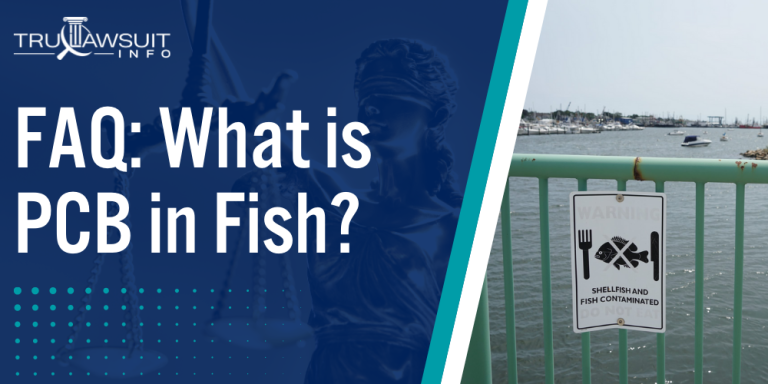
Intro to What is PCB in Fish?
Here are some key points about PCBs in fish:
- PCBs are persistent organic pollutants that can remain in the environment for long periods
- Fish can absorb PCBs directly from the water or by consuming contaminated prey
- Consuming fish with high levels of PCBs can lead to various health problems, including cancer and developmental issues
If you or a loved one has been exposed to PCBs and suffered health consequences, you may be eligible to file a PCB Lawsuit.
Contact TruLawsuit Info for a free consultation using the chat on this page to receive an instant case evaluation.
Table of Contents
Understanding Polychlorinated Biphenyls (PCBs)
Polychlorinated biphenyls, or PCBs, are synthetic organic chemicals that have gained notoriety as persistent environmental pollutants.
This section looks closely at their definition, chemical structure, and historical use.

Definition and Chemical Structure of PCBs
PCBs refer to a group of man-made chemicals that contain 209 individual compounds known as congeners.
The atoms within PCBs are arranged in unique structures featuring:
- Carbon
- Hydrogen
- Chlorine
PCG Congeners
These atoms can combine in various ways, giving rise to the distinct physical and chemical properties of each congener.
Exploring the unique characteristics of PCB congeners reveals several notable features:
- Chemical Stability: PCBs build are thermally resistant and don’t easily break down.
- Insulating Properties: Their non-conductivity makes them ideal for use in electrical equipment.
- Low Flammability: They are resistant to ignition, further enhancing their utility in electrical applications.
- Inertness: PCBs do not easily react with other chemicals, increasing their lifespan in the environment.
Historical Use and Production of PCB Chemicals
From the 1920s until their ban in the late 1970s, PCBs were heavily utilized in industrial and commercial applications.
They served as:
- Coolants and lubricants in electrical equipment, such as transformers and capacitors.
- Hydraulic fluids and plasticizers in industrial machinery.
- Additives in paint, carbonless copy paper, and other materials.
During their peak production, it’s estimated that:
- Millions of pounds of PCBs were manufactured.
- Production occurred worldwide, not limited to any single region.
- The presence of PCBs was ubiquitous in both commercial and industrial chemicals.
- Regulatory actions in the late 1970s, primarily due to their environmental impact and toxic properties, led to a drastic reduction and eventual discontinuation of PCB manufacturing.
Despite no longer being produced, PCBs remain entrenched as a chemical pollutant due to their resilience and continued presence in the environment.
How PCBs Accumulate in Fish
Polychlorinated biphenyls (PCBs) are persistent organic pollutants that find their way into aquatic environments and, subsequently, accumulate in the tissue of fish.
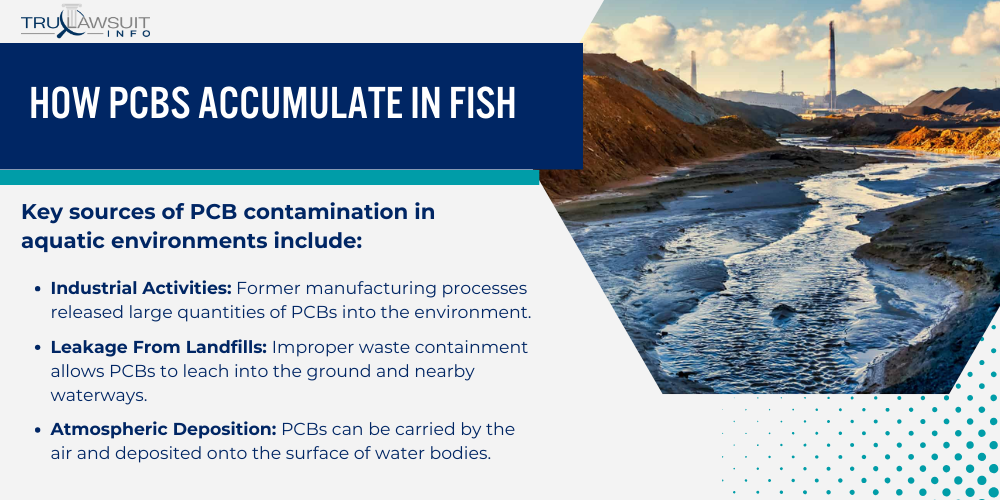
Understanding this process requires examining both the contamination sources and the biological mechanisms at play.
Environmental Contamination of Water Bodies with PCBs
PCBs enter water bodies through various pathways, typically originating from industrial waste and improper disposal practices.
Once in the environment, these chemicals bind strongly to sediment and soil, creating reservoirs for ongoing contamination.
Key sources of PCB contamination in aquatic environments include:
- Industrial Activities: Former manufacturing processes released large quantities of PCBs into the environment.
- Leakage From Landfills: Improper waste containment allows PCBs to leach into the ground and nearby waterways.
- Atmospheric Deposition: PCBs can be carried by the air and deposited onto the surface of water bodies.
- Spillage And Improper Disposal: Accidental spills and illegal dumping contribute to the contamination of aquatic habitats.
Bioaccumulation and Biomagnification in the Aquatic Food Chain
Bioaccumulation occurs when organisms absorb PCBs faster than they can eliminate them, leading to higher concentrations in their bodies than in the surrounding environment.
These compounds are especially prone to accumulate in the fatty tissues of organisms.
Biomagnification amplifies the concentration of PCBs at each successive level of the food chain.
The mechanisms through which organisms in aquatic environments are exposed to and accumulate PCBs include:
- Direct Uptake From Water: Aquatic organisms absorb PCBs present in the water through their skin and gills.
- Intake From Sediment: Bottom-dwelling species ingest PCBs when feeding on contaminated sediment.
- Dietary Accumulation: Fish consume smaller organisms and detritus-containing PCBs, which then accumulate in their own tissues.
- Food Chain Transmission: Predatory fish that eat smaller, PCB-laden fish have even higher levels of PCBs accumulated in their tissues.
Health Risks Associated with PCBs in Fish
Polychlorinated biphenyls (PCBs) are synthetic chemicals found in fish that pose serious health risks to humans, including cancer and neurological problems.
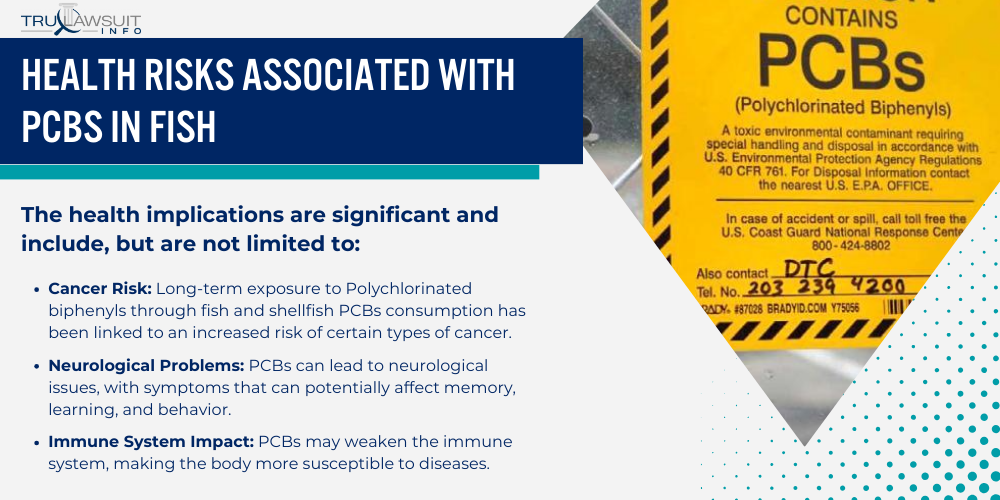
Potential Adverse Effects on Human Health
PCBs have been identified as probable human carcinogens.
The health implications are significant and include, but are not limited to:
- Cancer Risk: Long-term exposure to Polychlorinated biphenyls through fish and shellfish PCBs consumption has been linked to an increased risk of certain types of cancer.
- Neurological Problems: PCBs can lead to neurological issues, with symptoms that can potentially affect memory, learning, and behavior.
- Immune System Impact: PCBs may weaken the immune system, making the body more susceptible to diseases.
- Endocrine Disruption: These chemicals can interfere with hormone functions, which can lead to reproductive health issues.
Vulnerable Populations at Higher Risk
Certain segments of the population are at an elevated risk of the health ramifications associated with exposure to PCBs.
This is primarily due to differences in exposure levels, physiological factors, and the potential for bioaccumulation of these compounds.
Some populations are more vulnerable to the adverse health effects of PCBs:
- Pregnant Women: There is a risk for developmental problems in fetuses upon PCB exposure.
- Children: Young children, due to their developing systems, are particularly sensitive to PCBs.
- Frequent Fish Consumers: Individuals who frequently consume fish are likely to have a higher exposure to PCBs.
- Residents Near Contaminated Areas: Local populations living near contaminated water bodies might experience elevated levels of PCB exposure.
Factors Influencing PCBs in Fish
Polychlorinated biphenyls (PCBs) are industrial chemicals that accumulate in fish tissue, posing health risks to consumers.
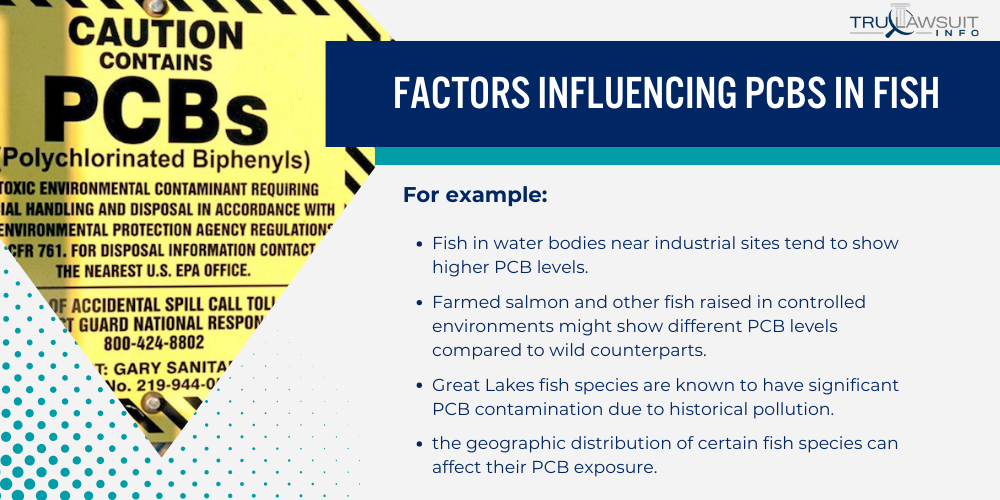
Several key factors influence the concentration of PCBs in various fish species.
Geographic Location and Proximity to Contaminated Sites
Fish in different geographic locations have varying PCB concentrations due to local industrial activities and proximity to contaminated sites.
For example:
- Fish in water bodies near industrial sites tend to show higher PCB levels.
- Farmed salmon and other fish raised in controlled environments might show different PCB levels compared to wild counterparts.
- Great Lakes fish species are known to have significant PCB contamination due to historical pollution.
- the geographic distribution of certain fish species can affect their PCB exposure.
Fish Species and Trophic Level
The species of fish and their position in the food chain greatly influence PCB accumulation.
Factors affecting PCB levels in different fish species include:
- Top predators, like salmon, tend to have higher levels of PCBs due to biomagnification.
- Fatty fish generally store more PCBs in their tissue.
- Filter feeders might have lower levels of PCBs but can still be affected based on their diet.
- Some species have metabolic pathways that can transform PCBs into different compounds, affecting the overall burden.
Age and Size of Fish
Fish age and size are significant factors that impact PCB accumulation.
Key points regarding how age and size affect PCB accumulation in fish:
- Generally, the larger and older the fish, the more PCBs it can accumulate.
- As fish age, their prolonged exposure leads to higher concentrations of PCBs.
- Younger fish may have lower levels, but they are still at risk if they inhabit contaminated areas.
- Contaminated fish that have lived for several years in a PCB-rich environment can have PCB levels far above those considered safe for human consumption.
Recommendations for Safe Fish Consumption
Consuming fish is part of a healthy diet, but it’s important to be aware of polychlorinated biphenyls (PCBs) in fish.
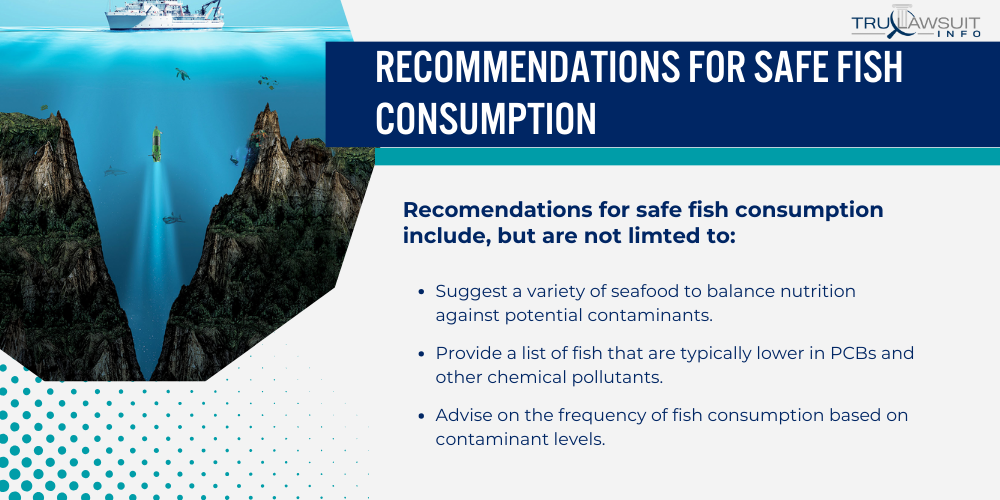
The following recommendations aim to reduce exposure to PCBs while still enjoying the benefits of fish.
EPA and FDA Guidelines on Fish Consumption
The Environmental Protection Agency (EPA) and the Food and Drug Administration (FDA) offer advice to minimize PCB intake.
They:
- Suggest a variety of seafood to balance nutrition against potential contaminants.
- Provide a list of fish that are typically lower in PCBs and other chemical pollutants.
- Advise on the frequency of fish consumption based on contaminant levels.
Choosing Fish Species with Lower PCB Levels
Certain fish species are known to have lower PCB levels.
When selecting seafood:
- Choose smaller, younger fish, as they tend to have accumulated fewer contaminants.
- Shellfish and smaller ocean fish like sardines and anchovies are generally safer choices.
- Be aware that fish from contaminated waters can have higher levels of PCBs.
- Check local fish consumption advisories to identify fish with lower contaminant levels.
Preparation and Cooking Methods to Reduce PCB Exposure
The way fish is prepared and cooked can impact the levels of PCBs.
To address the ongoing issue of PCBs in aquatic life, key strategies and facts include:
- Fish Advisories: Concerns about the high levels of PCBs in fish have led to fish advisories to ensure safe consumption.
- PCB Accumulation: These PCB compounds are particularly found in fish’s fatty tissue, skin, and internal organs.
- Cooking Practices: To reduce PCB intake, trim the fat, remove the skin, and eat the skinless fillet.
- Environmental Persistence: Classified PCBs can persist in water and soil for many years, continuing to pose a risk to wildlife and humans.
Monitoring and Regulation of PCB in Fish
Effective management of PCB contamination in aquatic environments is a significant concern for public health.
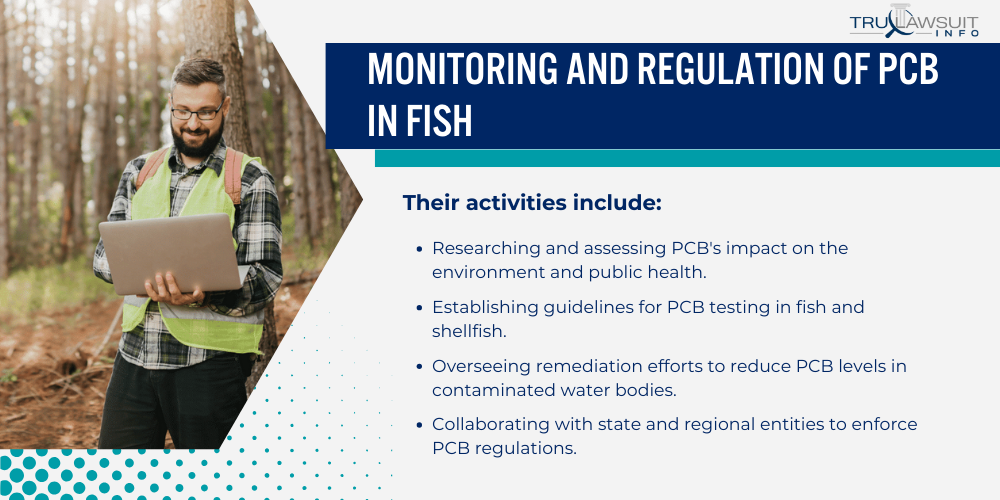
This section explores the agencies involved in testing and oversight and the criteria used to establish safe PCB levels in fish.
Government Agencies Responsible for Testing and Oversight
The Environmental Protection Agency (EPA) plays a pivotal role in the regulation and monitoring of PCBs in fish.
Their activities include:
- Researching and assessing PCB’s impact on the environment and public health.
- Establishing guidelines for PCB testing in fish and shellfish.
- Overseeing remediation efforts to reduce PCB levels in contaminated water bodies.
- Collaborating with state and regional entities to enforce PCB regulations.
Through these actions, the EPA aims to keep the public informed and to minimize the risks associated with PCB in fish.
Establishing Safe Limits for PCB in Fish
Safeguarding public health while promoting a balanced diet is paramount.
Determining acceptable PCB concentrations in fish tissue is a science-driven process that involves:
- Analyzing scientific data to understand the health effects of PCBs.
- Establishing threshold levels that reflect safe consumption limits, balanced against the nutritional benefits of fish.
- Regularly updating advisory levels for PCBs as new data becomes available.
- Communicating with the public about the significance of these limits and any related health advisories.
Government agencies collaborate to ensure that regulation measures reflect ongoing research and societal needs regarding PCB exposure from fish consumption.
Efforts to Reduce PCB Contamination in Aquatic Ecosystems
Reducing PCB contamination in aquatic ecosystems involves targeted actions to locate and clean up pollution sources as well as strict regulatory measures to prevent future contamination.
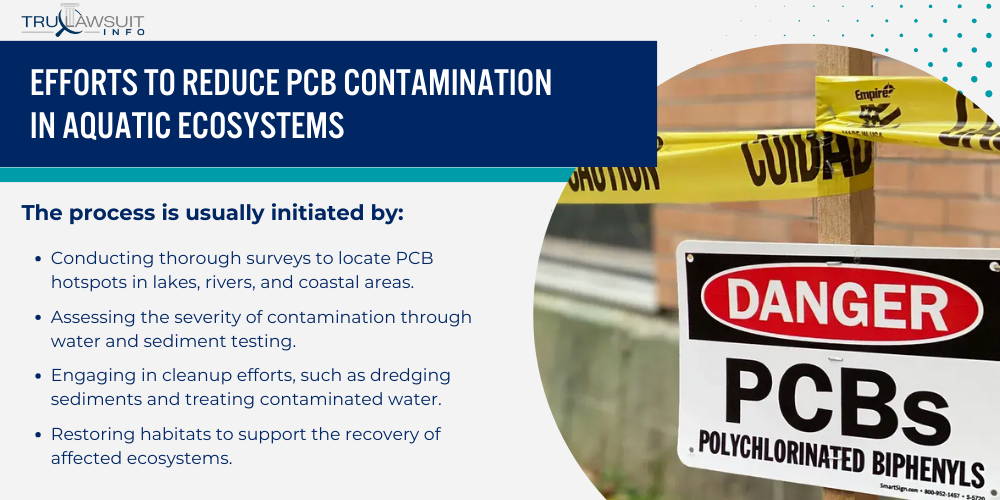
The following subsections provide insight into the key steps taken to mitigate the problem of PCBs in waterbodies and protect aquatic life, especially contaminated fish populations.
Identifying and Remediating Contaminated Sites
Remediation is a critical step in protecting aquatic ecosystems from PCB contamination.
The process is usually initiated by:
- Conducting thorough surveys to locate PCB hotspots in lakes, rivers, and coastal areas.
- Assessing the severity of contamination through water and sediment testing.
- Engaging in cleanup efforts, such as dredging sediments and treating contaminated water.
- Restoring habitats to support the recovery of affected ecosystems.
- Monitoring the effects of remediation on local aquatic populations over time.
- Involving community and stakeholder input to ensure transparent and effective actions.
Nature-based remediation technologies, for example, are being explored to help ecosystems recover effectively.
Implementing Regulations on PCB Disposal and Management
Regulations play an essential role in mitigating the impact of improper disposal of PCBs.
These regulations typically include:
- Setting stringent guidelines for the safe disposal of PCB-containing materials.
- Enforcing legal requirements for industries that generate or use PCBs in operations.
- Educating about the risks associated with PCB exposure and the importance of proper management.
- Providing resources for entities to manage and dispose of their PCB waste compliantly.
- Instituting penalties for non-compliance to deter negligent disposal practices.
For example, the U.S. EPA enforces laws designed to reduce PCB levels in the environment, including water bodies frequented by fish.
Balancing the Benefits and Risks of Fish Consumption
With an increasing awareness of dietary health, consumers often weigh the nutritional advantages of fish against potential health risks from pollutants like PCBs.
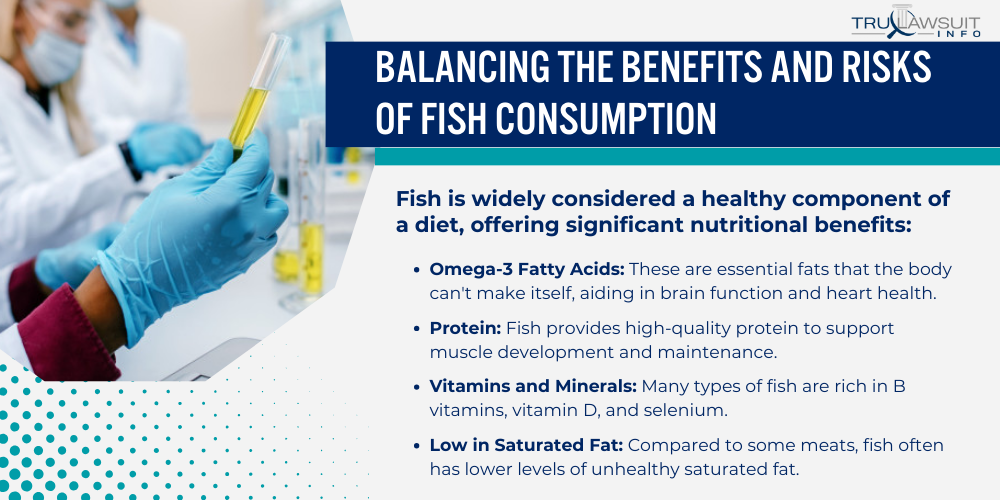
Understanding this balance is essential for making informed food choices.
Nutritional Value of Fish in a Healthy Diet
Fish isn’t just delicious and versatile; it’s a nutritional powerhouse.
Including fish in your diet provides a wealth of essential nutrients that contribute to your overall health and well-being.
Fish is widely considered a healthy component of a diet, offering significant nutritional benefits:
- Omega-3 Fatty Acids: These are essential fats that the body can’t make itself, aiding in brain function and heart health.
- Protein: Fish provides high-quality protein to support muscle development and maintenance.
- Vitamins and Minerals: Many types of fish are rich in B vitamins, vitamin D, and selenium.
- Low in Saturated Fat: Compared to some meats, fish often has lower levels of unhealthy saturated fat.
Eating fish can also provide a unique balance of nutrients not commonly found in other foods.
Making Informed Choices to Minimize PCB Exposure
While fish is a great source of lean protein and healthy fats, being mindful of potential PCB contamination allows you to maximize the health benefits and minimize any risks.
Being conscious of PCB exposure while consuming fish can protect one’s health:
- Select Fish Wisely: Choose species known for lower levels of contaminants and from less polluted waters.
- Moderation is Key: Limit the amount of fish that are higher in PCBs, such as certain lakes or farm-raised options.
- Cooking Methods Matter: Prepare fish in ways that reduce fat content, where PCBs may be stored.
- Stay Updated on Advisories: Government and health organizations issue guidelines on safe fish consumption; keeping abreast of these is beneficial.
One’s choice of fish can make a significant impact on the balance between its health benefits and the risks associated with contaminant exposure.
Frequently Asked Questions
-
What is the impact of polychlorinated biphenyls (PCBs) on human health?
PCBs are classified as probable human carcinogens and have been linked to a range of adverse health effects, including disruptions in the endocrine, reproductive, and immune systems.
Long-term exposure to PCBs is associated with an increased risk of certain types of cancer and may lead to developmental problems in children.
-
How do PCBs accumulate in fish?
Fish absorb PCBs from their environment through their gills and diet.
These compounds are lipophilic, meaning they accumulate in organisms’ fatty tissues and increase in concentration up the food chain through a process known as biomagnification.
-
Can you reduce your exposure to PCBs from fish consumption, and if so, how?
Consumers can reduce their PCB intake by choosing fish lower on the food chain, where PCB levels are generally lower, and by trimming and cooking methods that reduce fat, where PCBs are commonly stored.
-
What are the regulations regarding PCB levels in fish and seafood?
Governments have established guidelines and action levels for PCBs in fish and seafood to protect human health.
In the United States, the EPA has set a guideline of 0.02 mg/kg of PCBs in fish and shellfish consumed by humans.
-
What roles did PCBs serve in industrial applications before their ban?
Due to their chemical stability and insulating properties, PCBs were used in a variety of industrial applications before their ban in the 1970s, including as coolants and lubricants in electrical equipment.
-
How does the contamination of water bodies with PCBs affect aquatic life?
PCBs in aquatic environments harm wildlife by causing reproductive, developmental, and immune system problems in fish and other aquatic organisms.
These contaminants can also lead to changes in behavior and increased mortality rates in fish populations.

Experienced Attorney & Legal SaaS CEO
With over 25 years of legal experience, Jessie is an Illinois lawyer, a CPA, and a mother of three. She spent the first decade of her career working as an international tax attorney at Deloitte.
In 2009, Jessie co-founded her own law firm with her husband – which has scaled to over 30 employees since its conception.
In 2016, Jessie founded TruLaw, which allows her to collaborate with attorneys and legal experts across the United States on a daily basis. This hypervaluable network of experts is what enables her to share reliable legal information with her readers!
Have A Case?
Here, at Tru Lawsuit Info, we’re committed to helping victims get the justice they deserve.
To do this, we actively work to connect them with attorneys who are experts in litigating cases similar to theirs.
Would you like our help?
Tru Lawsuit Info is a reliable source of information about issues that may affect your health and safety, such as faulty products, data breaches, and environmental hazards.
Our team of experienced writers collaborates with medical professionals, lawyers, and advocates to produce informative articles, guides, and other resources that raise awareness of these topics.
Our thorough research provides consumers with access to reliable information and updates on lawsuits happening around the country. We also can connect consumers with attorneys if they need assistance.
Camp Lejeune's water contamination issue spanned several decades starting in the 1950s. Exposure to these chemicals has been linked to various serious health issues, including cancer, organ diseases, and death.
Research is increasingly suggesting a link between the use of Tylenol during pregnancy and the development of neurodevelopmental disorders, such as autism and ADHD, in infants.
Legal action is being taken against manufacturers of Aqueous Film-Forming Foam (AFFF), a chemical used in fighting fires. The plaintiffs allege that exposure to the foam caused health issues such as cancer, organ damage, and birth and fertility issues.
Have A Case?
Here, at Tru Lawsuit Info, we’re committed to helping victims get the justice they deserve.
To do this, we actively work to connect them with attorneys who are experts in litigating cases similar to theirs.
Would you like our help?







